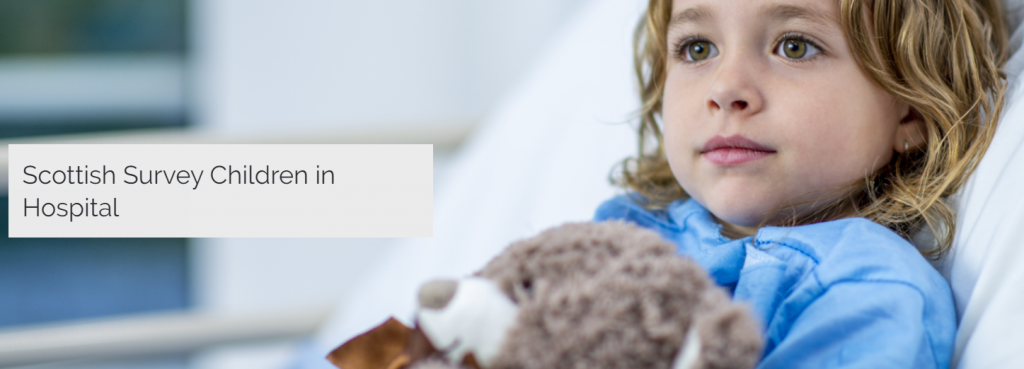Since 1985, Children’s Health Scotland (CHS, formerly Action for Sick Children Scotland) has carried out periodic surveys of Scottish NHS hospitals admitting children. Its eighth survey, in 2018 – 2019 assesses current parental access and family facilities provision, and the implementation of child healthcare policies and procedures. On October 30 the results were presented.
Its purpose is to highlight good practice and progress and to identify where improvements need to be made. Survey results have been benchmarked against the ten articles of the European Association for Children in Hospital (EACH) Charter, key standards for paediatric care.
The survey has been carried out in paediatric wards, neonatal units and hospitals with adult wards that admit children and young people in hospitals across Scotland.Additionally questionnaires have been sent to health board catering managers, lead paediatric dieticians and child health commissioners.
Results
Speaking about the research Professor Richard Olver, Chair of Children’s Health Scotland said: “Since our last survey in 2012-13, it is pleasing to note that progress has been achieved in the provision of hospital services for children and young people such as open visiting and the provision of overnight and on-ward facilities for parents or carers.”
“However, there are still areas for improvement particularly with reference to the standards set out in the EACH Charter. It is a fact that all children have an explicit right to achieve their developmental potential and to sustain the highest possible standard of health, with a right to appropriate health services to facilitate attainment of these goals”
“On analysis of the findings more needs to be done, especially in relation to admission to adult wards, the provision of healthcare rights information, and compliance with Scottish Government guidance on the provision of education and on the nutritional content of food in hospital. We now look forward to working with those in the sector to implement the recommendations within the report.”
Trends: Some key findings: comparison with 2012/13 survey
FACILITY/PROCEDURE |
2018/19 |
|||||
PARENTAL ACCESS |
Paediatric | Neonatal | Adult | |||
| Provision of open visiting for parents/carers | 89{60f83d427fa1bd0581e14e00752abb5a0f338dfffd4223419b474e528bcb0393} | 100{60f83d427fa1bd0581e14e00752abb5a0f338dfffd4223419b474e528bcb0393} | ↔ | 88{60f83d427fa1bd0581e14e00752abb5a0f338dfffd4223419b474e528bcb0393} | ↔ | |
PARENTAL FACILITIES AND ACCOMMODATION |
||||||
| Parents’ overnight accommodation at bedside in a bed or chair | 90{60f83d427fa1bd0581e14e00752abb5a0f338dfffd4223419b474e528bcb0393} | ↑ | 87{60f83d427fa1bd0581e14e00752abb5a0f338dfffd4223419b474e528bcb0393} | ↑ | 100{60f83d427fa1bd0581e14e00752abb5a0f338dfffd4223419b474e528bcb0393} | ↑ |
| Availability of a sitting room for parents/ carers 86{60f83d427fa1bd0581e14e00752abb5a0f338dfffd4223419b474e528bcb0393} 93{60f83d427fa1bd0581e14e00752abb5a0f338dfffd4223419b474e528bcb0393} n/a | 86{60f83d427fa1bd0581e14e00752abb5a0f338dfffd4223419b474e528bcb0393} | ↑ | 80{60f83d427fa1bd0581e14e00752abb5a0f338dfffd4223419b474e528bcb0393} | ↑ | n/a | |
| Self-catering facilities for parents/carers 86{60f83d427fa1bd0581e14e00752abb5a0f338dfffd4223419b474e528bcb0393} 80{60f83d427fa1bd0581e14e00752abb5a0f338dfffd4223419b474e528bcb0393} n/a | 86{60f83d427fa1bd0581e14e00752abb5a0f338dfffd4223419b474e528bcb0393} | ↑ | 80{60f83d427fa1bd0581e14e00752abb5a0f338dfffd4223419b474e528bcb0393} | ↑ | n/a | |
| Showering/washing facilities for parents/carers 80{60f83d427fa1bd0581e14e00752abb5a0f338dfffd4223419b474e528bcb0393} 80{60f83d427fa1bd0581e14e00752abb5a0f338dfffd4223419b474e528bcb0393} n/a | 80{60f83d427fa1bd0581e14e00752abb5a0f338dfffd4223419b474e528bcb0393} | ↑ | 80{60f83d427fa1bd0581e14e00752abb5a0f338dfffd4223419b474e528bcb0393} | ↑ | n/a | |
FAMILY SUPPORT |
||||||
| Access to a social worker 77{60f83d427fa1bd0581e14e00752abb5a0f338dfffd4223419b474e528bcb0393} 67{60f83d427fa1bd0581e14e00752abb5a0f338dfffd4223419b474e528bcb0393} 100{60f83d427fa1bd0581e14e00752abb5a0f338dfffd4223419b474e528bcb0393} | 77{60f83d427fa1bd0581e14e00752abb5a0f338dfffd4223419b474e528bcb0393} | ↑ | 67{60f83d427fa1bd0581e14e00752abb5a0f338dfffd4223419b474e528bcb0393} | 100{60f83d427fa1bd0581e14e00752abb5a0f338dfffd4223419b474e528bcb0393} | ↑ | |
| Young people’s services | ||||||
| 14-16 year-olds accommodated in a specialist unit or ward 15{60f83d427fa1bd0581e14e00752abb5a0f338dfffd4223419b474e528bcb0393} n/a n/a | 15{60f83d427fa1bd0581e14e00752abb5a0f338dfffd4223419b474e528bcb0393} | ↑ | n/a | n/a | ||
| Choice of children’s or adult wards for young people 9{60f83d427fa1bd0581e14e00752abb5a0f338dfffd4223419b474e528bcb0393} n/a n/a | 9{60f83d427fa1bd0581e14e00752abb5a0f338dfffd4223419b474e528bcb0393} | n/a | n/a | |||
CHILDREN ADMITTED FOR SURGERY |
||||||
| Dedicated surgery lists 75{60f83d427fa1bd0581e14e00752abb5a0f338dfffd4223419b474e528bcb0393} n/a n/a | 75{60f83d427fa1bd0581e14e00752abb5a0f338dfffd4223419b474e528bcb0393} | n/a | n/a | |||
| Allowing parents to stay with child until anaesthetised 100{60f83d427fa1bd0581e14e00752abb5a0f338dfffd4223419b474e528bcb0393} n/a n/a | 100{60f83d427fa1bd0581e14e00752abb5a0f338dfffd4223419b474e528bcb0393} | ↑ | n/a | n/a | ||
| Allowing parents to be with their child in recovery 61{60f83d427fa1bd0581e14e00752abb5a0f338dfffd4223419b474e528bcb0393} n/a n/a | 61{60f83d427fa1bd0581e14e00752abb5a0f338dfffd4223419b474e528bcb0393} | n/a | n/a | |||
INFORMATION, RECORDS AND FEEDBACK |
||||||
| Information for parents on reimbursement of travel costs 49{60f83d427fa1bd0581e14e00752abb5a0f338dfffd4223419b474e528bcb0393} 93{60f83d427fa1bd0581e14e00752abb5a0f338dfffd4223419b474e528bcb0393} n/a | 49{60f83d427fa1bd0581e14e00752abb5a0f338dfffd4223419b474e528bcb0393} | 93{60f83d427fa1bd0581e14e00752abb5a0f338dfffd4223419b474e528bcb0393} | ↔ | n/a | ||
| Availability of written information for families about ward procedures on admission 34{60f83d427fa1bd0581e14e00752abb5a0f338dfffd4223419b474e528bcb0393} 53{60f83d427fa1bd0581e14e00752abb5a0f338dfffd4223419b474e528bcb0393} n/a | 34{60f83d427fa1bd0581e14e00752abb5a0f338dfffd4223419b474e528bcb0393} | 53{60f83d427fa1bd0581e14e00752abb5a0f338dfffd4223419b474e528bcb0393} | n/a | |||
| Young people given information about consent 74{60f83d427fa1bd0581e14e00752abb5a0f338dfffd4223419b474e528bcb0393} n/a 56{60f83d427fa1bd0581e14e00752abb5a0f338dfffd4223419b474e528bcb0393} | 74{60f83d427fa1bd0581e14e00752abb5a0f338dfffd4223419b474e528bcb0393} | n/a | 56{60f83d427fa1bd0581e14e00752abb5a0f338dfffd4223419b474e528bcb0393} | |||
| Young people given information about confidentiality 76{60f83d427fa1bd0581e14e00752abb5a0f338dfffd4223419b474e528bcb0393} n/a 44{60f83d427fa1bd0581e14e00752abb5a0f338dfffd4223419b474e528bcb0393} | 76{60f83d427fa1bd0581e14e00752abb5a0f338dfffd4223419b474e528bcb0393} | n/a | 44{60f83d427fa1bd0581e14e00752abb5a0f338dfffd4223419b474e528bcb0393} | |||
EDUCATION |
||||||
| Compliance with Scottish Government guidelines on education1 36{60f83d427fa1bd0581e14e00752abb5a0f338dfffd4223419b474e528bcb0393} n/a n/a | 36{60f83d427fa1bd0581e14e00752abb5a0f338dfffd4223419b474e528bcb0393} | ↑ | n/a | n/a | ||
| Provision of teaching for children from other local authority areas 45{60f83d427fa1bd0581e14e00752abb5a0f338dfffd4223419b474e528bcb0393} n/a n/a | 45{60f83d427fa1bd0581e14e00752abb5a0f338dfffd4223419b474e528bcb0393} | n/a | n/a | |||
CATERING |
||||||
| Specific menus for children and young people 83{60f83d427fa1bd0581e14e00752abb5a0f338dfffd4223419b474e528bcb0393} n/a 43{60f83d427fa1bd0581e14e00752abb5a0f338dfffd4223419b474e528bcb0393} | 83{60f83d427fa1bd0581e14e00752abb5a0f338dfffd4223419b474e528bcb0393} | n/a | 43{60f83d427fa1bd0581e14e00752abb5a0f338dfffd4223419b474e528bcb0393} | ↑ |

